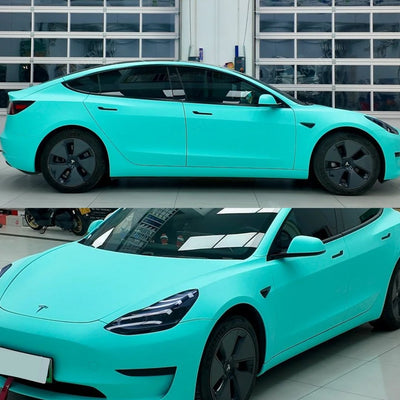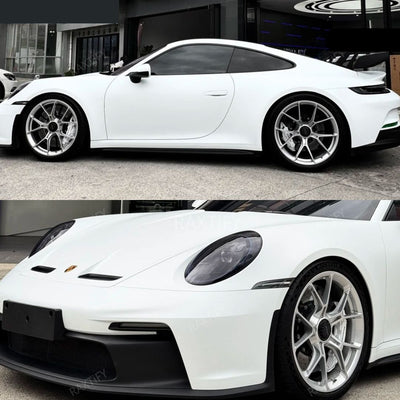Paint Protection Film Wraps Vs Vinyl Wrap
If you're a car owner, you've likely pondered, "Which is superior: Vinyl Wrap or Paint Protection Film Wraps (PPF)?" Navigating traffic can be a nightmare, with noise pollution and crowded roads making driving a daily ordeal. One solution to these woes is adding PPF to your vehicle.
Although PPF and vinyl wrap may seem similar in appearance and function, they differ significantly. In this blog post, we'll delve into the pros and cons of vinyl wrap versus PPF. Understanding these distinctions can aid you in choosing the optimal wrap for your vehicle. Whether you opt for a wrap or a plastic protection film, now is the time to decide.
Consider various factors before selecting the ideal material to safeguard your vehicle's exterior. These include installation costs, durability, and product availability. Both vinyl wrap and PPF serve to shield vehicles from the elements.
Vinyl wrap: What Is It And How Does It Work?
Vinyl wrap is a versatile solution for covering your vehicle's exterior with a protective layer of vinyl. This innovative product not only enhances the appearance of your vehicle with stylish accents but also shields it from environmental damage, ensuring it stays in top condition. Crafted from flexible vinyl material, it snugly fits over your vehicle's surface, offering comprehensive coverage. Whether it's cars, trucks, SUVs, or recreational vehicles, vinyl wrap can benefit them all.
Comprised of a vinyl layer with adhesive backing, vinyl wrap adheres securely to various surfaces and materials. Its protective qualities guard against scratches, chips, and abrasions, providing a durable shield over the car's paint. This eliminates the need for costly repairs or replacements in the event of accidents. Additionally, vinyl wrap offers versatility in design, with a wide range of colors and patterns available to complement any vehicle theme. And the best part? It's easily removable and can be reapplied as desired, offering flexibility and convenience for vehicle customization.
Paint Protection Film (PPF): What Is It And How Does It Work?
Paint Protection Film (PPF) serves as a transparent shield, safeguarding your vehicle's surface against scratches and chips caused by road debris, such as stone chips, tree sap, and other potential hazards. Applied during detailing or specialized protection services, PPF comes in two varieties: ceramic and vinyl.
Ceramic PPF, available in clear or semi-gloss finishes, not only shields against damage but also enhances your paint's luster by reflecting light. On the other hand, Vinyl PPF, boasting a matte finish, focuses on preserving your vehicle's color integrity, warding off dirt and grime absorption.
What sets PPF apart is its versatility. Beyond automobiles and motorcycles, it can safeguard various surfaces like motorcycle helmets, scooters, ATVs, and even golf karts. Application is a breeze: simply peel off the protective backing, adhere it to the desired surface, and press firmly with a credit card or ruler for optimal adhesion.
Vinyl Wraps Vs PPF
Choosing between vinyl wraps and paint protection film (PPF) can be challenging, as there are several factors to consider before making your decision.
Material
Vinyl wraps are crafted from PVC, while paint protection film is made from polypropylene. Both materials are plastic-based, but they possess distinct properties. Vinyl wraps are generally tougher than PPF, yet they tend to present a sleeker appearance when installed correctly. However, improper installation may shorten the lifespan of vinyl wraps.
Appearance
At first glance, vinyl wraps and PPF may appear similar with smooth surfaces and comparable color and texture. Nonetheless, subtle differences exist between them. Vinyl wraps, being more translucent, can enhance the visual appeal of your vehicle, especially when regularly maintained. Conversely, PPF is ideal for long-term parking scenarios due to its enhanced durability against wear and tear.
Protection
Vinyl wraps offer protection against UV rays, insects, and external damage, but they do not shield the vehicle's interior from moisture or chemicals. For regions experiencing frequent snow or rain, PPF or a spray-on coating may provide better water/moisture resistance.
Lifespan
The lifespan of vinyl wraps versus PPF depends largely on maintenance. Proper care and cleaning can prolong the lifespan of vinyl wraps, while neglect may lead to damage. However, with adequate upkeep, vinyl wraps can outlast PPF.
Cost
PPF is typically more expensive than vinyl wraps. The cost of vinyl wraps, including labor, ranges from $1000 to $4000, while PPF costs $5 to $10. PPF's higher cost is attributed to its superior durability and recyclable nature.
Installation
Vinyl wraps are easier to install compared to PPF, as they come with adhesive backing and can be removed effortlessly. This makes them suitable for DIY projects or self-installation, while PPF requires adhesive application before wrapping the vehicle.
Durability
Vinyl wraps offer durability against various elements and weather conditions, making them a cost-effective long-term solution compared to PPF.
Maintenance
Vinyl wraps require regular cleaning and maintenance to prevent peeling and maintain appearance. Conversely, PPF requires minimal maintenance due to its design, which prevents dirt and dust buildup.
Frequently Asked Questions: Vinyl Wrap vs PPF
Q: What's the difference between PPF and vinyl?
A: PPF and vinyl are both thermoplastic polymers. The key difference lies in their composition. Vinyl wrap is crafted from acrylic resin, making it flexible and durable. On the other hand, PPF is derived from polypropylene fiber, which lends it rigidity and prevents stretching.
Q: Is PPF stronger than vinyl?
A: Yes, PPF boasts greater strength compared to vinyl. Its higher melting point and enhanced flexibility mean it's less prone to cracks or damage when molded into shapes. In contrast, vinyl's lower melting point makes it more susceptible to breaking when bent.
Q: Vinyl Wrap Vs PPF: Which one is better?
A: The decision boils down to your specific needs. Opt for vinyl wraps if you aim to enhance your vehicle's appearance. Alternatively, choose Paint Protection Film (PPF) for comprehensive vehicle protection. Vinyl wraps are lighter and easier to handle, install, remove, and store, making them a convenient choice. Additionally, they are more budget-friendly than PPF, reducing maintenance costs and insurance premiums over time.
Conclusion
In the end, your decision should reflect your preferences and requirements. Choosing between PPF and vinyl wrap should prioritize function over appearance. For example, if you prefer a consistently shiny and glossy appearance for your car, then vinyl wrap is the ideal choice. On the other hand, if durability and protection against scratches and damage for an extended period (2-3 years) are your main concerns, then PPF is the superior option. While comparing these alternatives may seem challenging, categorizing them differently enables you to make a more informed decision based on your specific needs and preferences.
































